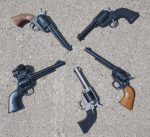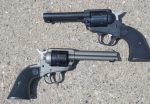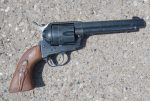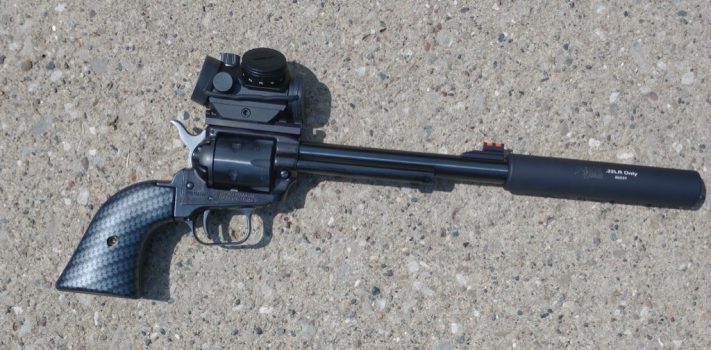I was organizing my gun safes, and realized that I had somehow accumulated five single-action .22 rimfire revolvers. I thought that a short article about them, how accurate or not they are, and whether or not various brands of ammunition make an accuracy difference might be of interest to SurvivalBlog readers. To preview the conclusion, yes, if…
 I’ll start with the latest acquisition first. I was at a gun show earlier this year, not intending to purchase anything, and ran across one of the latest offerings from Heritage Arms. Heritage has been making the Rough Rider .22 single-action revolver in the USA since 1992. For many years, they had one offering, A small frame copy (or replica) looking like the classic Colt Peacemaker, with a 6.5-inch barrel. I have owned one of these for around 25 years. More on that one later. Today, the offerings from Heritage have expanded quite a bit. They offer revolvers from one-inch to 16 inch barrels, birds head and standard plow handle grip frames. Fixed or adjustable sights, quite a few grip and finish options, and many other variations. They even have a really interesting Carbine version. I had told myself that I didn’t need another “cheap” Heritage revolver, even if they were pretty sharp looking. Then I found a threaded barrel, tactical model complete with Picatinny rail, and just had to find out if a suppressor would really work on a revolver. Spoiler Alert: Not really.
I’ll start with the latest acquisition first. I was at a gun show earlier this year, not intending to purchase anything, and ran across one of the latest offerings from Heritage Arms. Heritage has been making the Rough Rider .22 single-action revolver in the USA since 1992. For many years, they had one offering, A small frame copy (or replica) looking like the classic Colt Peacemaker, with a 6.5-inch barrel. I have owned one of these for around 25 years. More on that one later. Today, the offerings from Heritage have expanded quite a bit. They offer revolvers from one-inch to 16 inch barrels, birds head and standard plow handle grip frames. Fixed or adjustable sights, quite a few grip and finish options, and many other variations. They even have a really interesting Carbine version. I had told myself that I didn’t need another “cheap” Heritage revolver, even if they were pretty sharp looking. Then I found a threaded barrel, tactical model complete with Picatinny rail, and just had to find out if a suppressor would really work on a revolver. Spoiler Alert: Not really.
A great thing about Heritage is that they don’t sell what we used to call in the software industry “vaporware”. Quite a few manufacturers promote guns through ads or articles in gun magazines that are not really available yet. I have never seen that from Heritage, in fact, I had not seen an ad for the tactical model until after I saw this one on the gun show table.
 Anyway, back to the gun. It has a 6.5-inch barrel, accessory rail and threaded muzzle. Plain black finish with carbon fiber grips. One unique feature of the Heritage revolvers is that they have a manual safety. I think it is a bit on the ugly side, but since there is no transfer bar on it, the safety is needed if you want to carry the revolver with 6 rounds. You can also use it to win a Facebook debate with self important experts who will tell you that revolvers don’t have safeties. The trigger pull is great. I can’t find my trigger pull scale (hence the need to clean out the gun safes), but I would guess it is well under 5 pounds and very crisp with no over travel. I had a Bushnell TRS 25 red dot sight that I had picked up years before at Walmart on clearance still in the box (another benefit of cleaning out the gun safes) and mounted it on the revolver.
Anyway, back to the gun. It has a 6.5-inch barrel, accessory rail and threaded muzzle. Plain black finish with carbon fiber grips. One unique feature of the Heritage revolvers is that they have a manual safety. I think it is a bit on the ugly side, but since there is no transfer bar on it, the safety is needed if you want to carry the revolver with 6 rounds. You can also use it to win a Facebook debate with self important experts who will tell you that revolvers don’t have safeties. The trigger pull is great. I can’t find my trigger pull scale (hence the need to clean out the gun safes), but I would guess it is well under 5 pounds and very crisp with no over travel. I had a Bushnell TRS 25 red dot sight that I had picked up years before at Walmart on clearance still in the box (another benefit of cleaning out the gun safes) and mounted it on the revolver.
My first step was to try it with a suppressor. While I don’t have the equipment to measure sound, to my Mark 1 issued ear, [because of the cylinder gap] it sounded almost as loud with and without a suppressor, and a lot louder than one of my suppressed .22 semi-auto pistols. So much for that theory, no, you can’t effectively suppress a standard revolver (except for something like a gas-sealed Russian Nagant). Next up, the accuracy test. With the red dot sight on it, using Remington bulk packed Golden Bullets. Suppressed, it shot a 2 ¼ inch group at 15 yards, with a couple of bullets that key holed (tumbled). Without the suppressor, the group tightened up to ¾ inches. My standard for a revolver like this is whether or not I can hit a squirrel or rabbit in the head at 15 yards, this revolver definitely passed.
 Next up, the older Heritage revolver. Fit and finish on this is not up to the current standards, plus it has not been babied over the 25 or so years of its life. Trigger pull, however, was quite good, just as on the newer Heritage. This one also has a 6.5-inch barrel. The spring that holds open the loading gate is a bit on the weak side, and I had to be careful not to bump it as I loaded the cylinder or it would close on me. Shooting the same bulk ammo I was able to shoot a 1 1/8 inch group. Definitely acceptable. I have seen these older guns at shows for under $100, However, you can find new ones on sale at some of the big box gun departments for $120 or less, so I am not sure it is worth buying a used one.
Next up, the older Heritage revolver. Fit and finish on this is not up to the current standards, plus it has not been babied over the 25 or so years of its life. Trigger pull, however, was quite good, just as on the newer Heritage. This one also has a 6.5-inch barrel. The spring that holds open the loading gate is a bit on the weak side, and I had to be careful not to bump it as I loaded the cylinder or it would close on me. Shooting the same bulk ammo I was able to shoot a 1 1/8 inch group. Definitely acceptable. I have seen these older guns at shows for under $100, However, you can find new ones on sale at some of the big box gun departments for $120 or less, so I am not sure it is worth buying a used one.
Heritage offers an auxiliary .22 magnum cylinder for $29. While I don’t have much use for a 22 magnum revolver, I’ll probably order one because it is so inexpensive. Why not?
Gun number three has quite a story. It is a 1960s-vintage Hawes single action in .22 magnum. I got it in an unusual trade years ago. I had bought a small John Deere trailer designed to carry a riding mower. It was buried up to the hubs, overgrown in a garden at an estate sale. I bought it for $5. I put two new wheels on it and a plywood deck on it. (This was back when plywood was affordable.) I listed it for something like $150 on Craigslist. This was long before the advent of Facebook Marketplace.
I got a call from a woman who told me that the trailer that she had used for her wheelchair had been stolen. She wondered if I could bring the trailer over, so she and her friend could look at it. I did, and she wanted it, but wanted to trade if I was willing to do so. She was in her 90s, and her late husband had been an over-the-road truck driver running between Iowa and Chicago from the 1940s through the 1980s. She had two guns she wanted to get rid of. One was the Hawes revolver, and the other was an old Stevens 16 gauge double that the husband had crudely sawed off the barrels to 18-½ inches, and added a pistol grip.
She told me the husband always had them handy when he hit the Chicago city limits, and one time had a guy jump into the cab through the passenger door, and jump out even faster when he saw the shotgun’s barrels pointing at his face. Anyway, I would have given her the trailer for free. After all, who steals from a 90-year-old lady? But she insisted. So I accepted the Hawes revolver, in trade.
 Accuracy is better than you would expect from an inexpensive gun this old chambered in .22 magnum. 15-yard groups run about 2 inches. Although I don’t have much use for a 22 magnum around here, it would probably be great out west hunting jackrabbits. One “custom” feature on this gun is a set of homemade walnut grips with a carved naked lady on them. Front view on the right grip, rear view on the left grip. She told me her husband carved them, using her as the model. Quite a lady!
Accuracy is better than you would expect from an inexpensive gun this old chambered in .22 magnum. 15-yard groups run about 2 inches. Although I don’t have much use for a 22 magnum around here, it would probably be great out west hunting jackrabbits. One “custom” feature on this gun is a set of homemade walnut grips with a carved naked lady on them. Front view on the right grip, rear view on the left grip. She told me her husband carved them, using her as the model. Quite a lady!
Guns four and five are Ruger Wranglers. The Wrangler is a budget gun, currently with a street price around $229. Ruger makes extensive use of their MIM (Metal Injection Molding) technology to help keep the gun affordable. It is also finished with various colors of Cerrkote. If you are not familiar with it, Cerakote is a high-tech spray-on and baked finish that I have found to be extremely durable. I had a Smith and Wesson Model 19 finished in OD Green Cerakote with black trim (Okay haters, to explain: The previous owner had stripped the finish off the barrel and cylinder with coarse sandpaper.) The new Cerakote finish not only looks great, but not even high velocity .357 magnum ammunition has been able to mark it.
Back to the Wranglers… I had a black one that I bought new for $179 and a silver one I bought like new from a pawn shop for the same price, after the street price for new ones had jumped up to $229. The Wrangler is roughly the same size as the current Ruger single six. Holsters fit both, and I am told that the grips are interchangeable, although I have not tried it myself.
Shooting at 15 yards the silver one grouped to 2-¼ inches, acceptable if not outstanding. The black one, however, shot to 4 ½ inches. I even tried Winchester Silvertips in it with the same result – 4 ½ inch groups. I called Ruger, and they agreed that this was outside of their accuracy standard. They e-mailed me a prepaid shipping sticker and I sent it in for them to look at. Three weeks later, I got it back. They had tested it with CCI Mini Mags and managed to shoot a 2-3/4 inch group at 10 yards, which they said met their standards. They returned it to me along with the test target. Apparently based on their target, putting six rounds into a 2-¾ inch box is acceptable at 10 yards. For those who don’t remember the Pythagorean theorem, the diagonal of a box that size is just under 4 inches. To me, that is not acceptable. After all, it was Townsend Whelen who said: “…only accurate <guns> are interesting”. Ruger was nice enough to include a free Ruger branded cleaning cloth for my trouble. Don’t get me wrong, Ruger is well known for their customer support and it has been excellent any time I have used it. I am just a bit dissatisfied with their accuracy standard for the Wrangler.
Well, my first thought was to trade the black Wrangler off at the next gun show, but then I thought, why not try the same protocol I have used with target rifles and try various brands of ammunition with it. While I was at it, I re-shot the two Heritage revolvers with the same ammunition.
A quick stop on my ammo shelves produces four more brands of .22 ammo to try. Copper plated CCI Mini Mags, Lead standard velocity Aguila ammunition (Aguila makes great products if you are not familiar with them), Lead High Velocity Federal ammunition and Lead bullet Remington Thunderbolt. Both Heritage revolvers shot about as accurately with each of these loads as they did the first go around with Remington Golden bullets. I did have a surprise when the Heritage tactical revolver shot a 1 ¾ group with the CCI Mini Mags with half of the bullets keyholing. I now know that revolver does not like this load.
The silver Wrangler really liked the CCI Mini Mags, shooting a 1-½ inch group. The black Wrangler however did not like the mini mags, shooting into three inches. The opposite was true with the lead Federal hi velocity rounds, with the Black Wrangler tightening up to 1-½ inches, and the silver Wrangler opening up to 2-½ inches.
Conclusion
So, does the .22 single action have a role in the prepper’s armory? Yes, if it is accurate. It is a great gun to start new shooters on and accurate enough for small game. You may have to try different loads to find one that the gun prefers, but that is part of the fun. If you just can’t find an acceptable load for a given revolver, then you can likely sell or trade it for about what you have in it, and try a different one.
I did also try CCI .22 shotshells in the Wrangler. At three yards, the number 12 shot pretty much covered an 8-½-inch by 11-inch target with no mouse-sized voids, so these would also make an effective gun for pest control.










